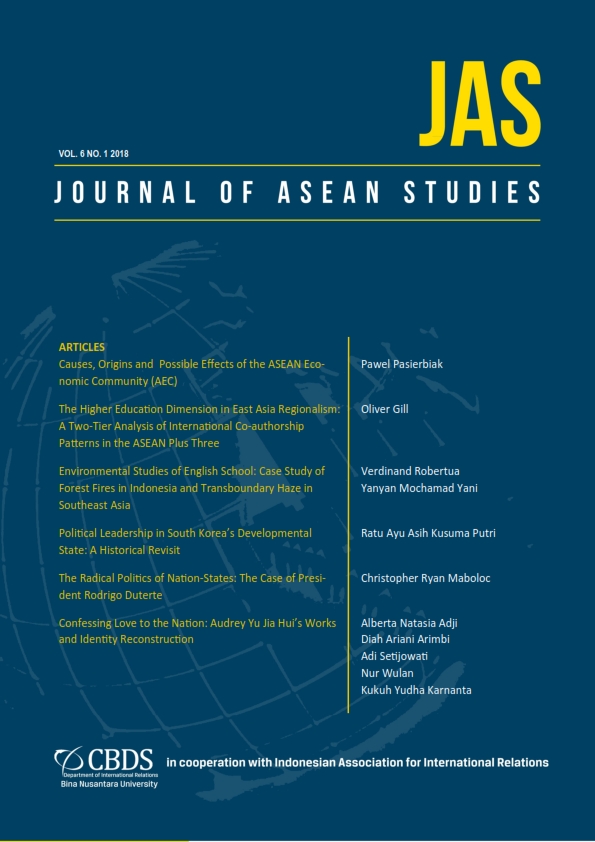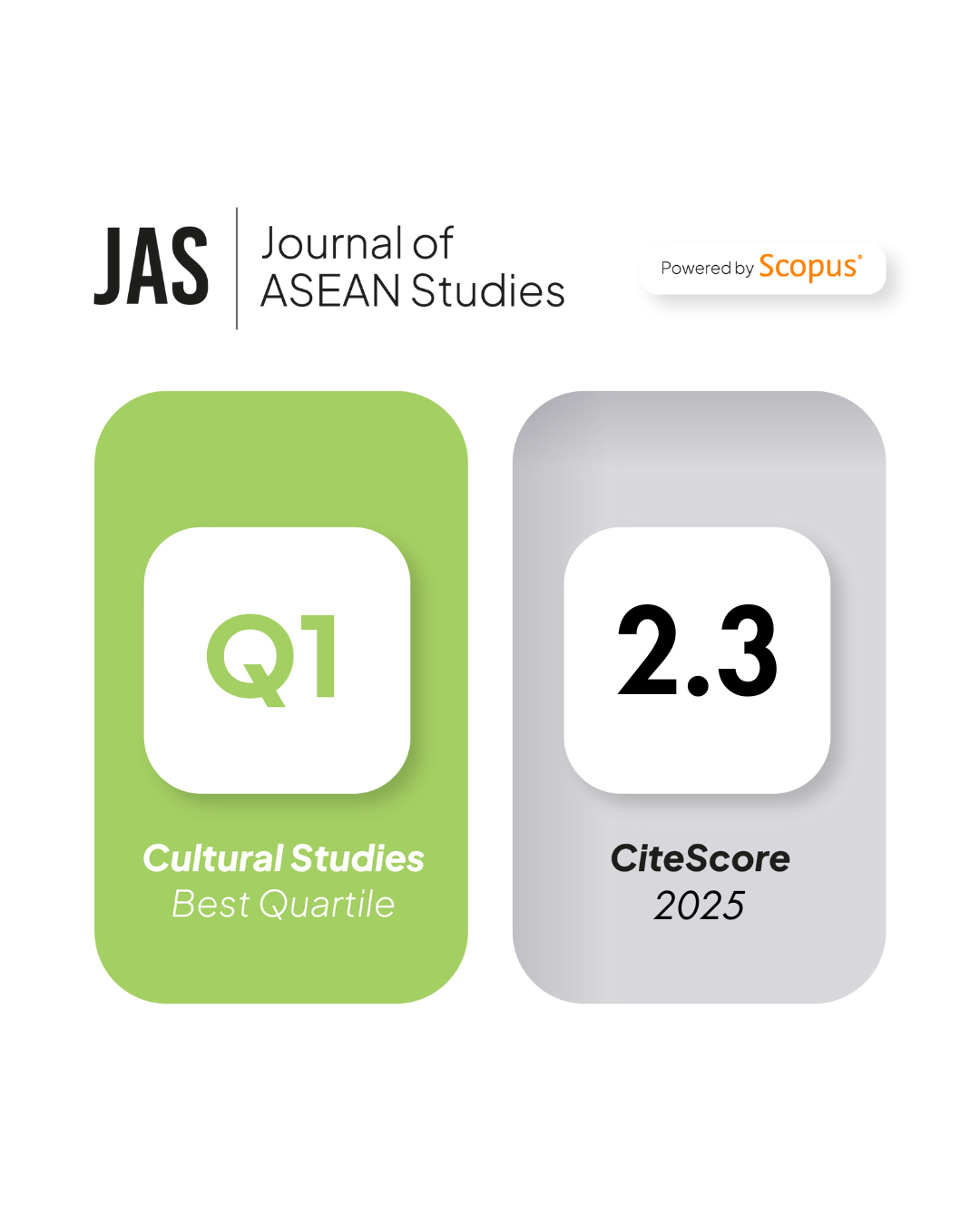The Higher Education Dimension in East Asian Regionalism: A Two-tier Analysis of International Co-authorship Patterns in the ASEAN Plus Three
DOI:
https://doi.org/10.21512/jas.v6i1.3963Keywords:
international co-authorship, higher education regionalism, higher education regionalisation, ASEAN University Network (AUN), ASEAN 3 University Network (ASEAN 3 UNet), Southeast Asian Ministers of Education Organisation (SEAMEO)Abstract
The AUN and ASEAN+3 UNet have both sought to promote the development of a distinct higher education research community within Southeast Asia and East Asia, respectively. The purpose of this paper is two-fold. Firstly, it aims to assess the success of these organisations in delivering against this aim, reviewed against inter-regional comparators. Secondly, the paper undertakes an assessment of which countries (if any) might be predominant in driving this agenda forward, at the intra-regional level. In both levels of the investigation, a statistical analysis of changes in international co-authorship patterns across time is utilised as the means of assessing the question at hand. In accordance with the paper’s core hypotheses, the findings indicate broad fulfilment of the AUN and ASEAN+3 UNet’s objectives, although it seems that efforts directed at building an East Asian research community have been comparatively more successful than those directed specifically at Southeast Asia. It is also found that, in a relative sense, South Korea is acting as a principal locus for higher educational regionalisation. The paper concludes by considering the implications of the analysis for East Asian higher education regionalism, with the contention being that the establishment of the aforementioned research communities provides a robust basis for the development of more formal integrative measures.
References
ASEAN+3 UNet (2009). Recommendations of the ASEAN+3 Higher Education Policy Dialogue. Retrieved 4 January 2017, from http://www.aunsec.org/policy.php
Asia-Pacific Education Ministers’ Meeting (APEM) (2006). The Brisbane Communiqué. Brisbane: APEM.
AUN (2017). History and Background. Retrieved 4 January 2017, from http://www.aunsec.org/ourhistory.php
Beeson, M. (2003). ASEAN Plus Three and the Rise of Reactionary Regionalism. Contemporary Southeast Asia, 25(2), 251-268.
Campanini, A. (2015). Bologna Process. In J.D. Wright (Ed.), International Encyclopedia of the Social & Behavioural Sciences (2nd ed.) (pp.741-746). Oxford: Elsevier.
Chan, S. (2012). Shifting Patterns of Student Mobility in Asia. Higher Education Policy, 25(2), 207-224.
Chao Jr., R.Y. (2011). Reflections on the Bologna Process: the making of an Asia Pacific Higher Education Area. European Journal of Higher Education, 1(2-3), 102-118.
Chao Jr., R.Y. (2014). Pathways to an East Asian Higher Education Area: a comparative analysis of East Asian and European regionalisation processes. Higher Education, 68(4), 559-575.
Cho, Y.H., & Palmer, J.D. (2013). Stakeholders’ views of South Korea’s higher education internationalisation policy. Higher Education, 65(3), 291-308.
Clark, N. (2012). Understanding Transnational Education, Its Growth and Implications. World Education News and Reviews. Retrieved 21 January 2017, from http://wenr.wes.org/2012/08/wenr-august-2012-understanding-transnational-education-its-growth-and-implications
Cummings, W.K. (2014). Asian Research: The Role of Universities. In A. Yonezawa, Y. Kitamura, A. Meerman, & K. Kuroda (Eds.), Emerging International Dimensions in East Asian Higher Education (pp.35-54). London: Springer.
EURYDICE (2009). Higher Education in Europe 2009: Developments in the Bologna Process. Brussels: EURYDICE.
Feuer, H.N., & Hornidge, A. (2015). Higher Education cooperation in ASEAN: building towards integration or manufacturing consent? Comparative Education, 51(3), 327-352.
Gress, D.R., & Ilon, L. (2009). Successful integration of foreign faculty into Korean universities: A proposed framework. KEDI Journal of Educational Policy, 6(2), 183-204.
Hawkins, J.N. (2012). Regionalisation and harmonisation of higher education in Asia. Asian Education and Development Studies, 1(1), 96-108.
Hidetaka, Y. (2005). Political Leadership, Informality, and Regional Integration in East Asia: The Evolution of ASEAN Plus Three. European Journal of East Asian Studies, 4(2), 205-232.
Huisman, J., Adelman, C., Hsieh, C., Shams, F., & Wilkins, S. (2012). Europe’s Bologna Process and its Impact on Global Higher Education. In D.K. Deardorff, H. de Wit, J.D. Heyl, & T. Adams (Eds.), The SAGE Handbook of International Higher Education (pp.81-100). Thousand Oaks: SAGE.
Hund, M. (2003). ASEAN Plus Three: towards a new age of pan-East Asian regionalism? A skeptic’s appraisal. The Pacific Review, 16(3), 383-417.
Iammarino, S., & Archibugi, D. (2005). Atlantic interdependent knowledge-based economies. In G. Boyd, A.M. Rugman, & P.C. Padoan (Eds.), European-American Trade and Financial Alliances (pp.24-51). Cheltenham: Edward Elgar.
Jung, J. (2012). International Research Collaboration among Academics in China and South Korea. International Journal of Chinese Education, 1(2), 235-254.
Katz, J.S., & Martin, B.R. (1997). What is research collaboration? Research Policy, 26(1), 1-18.
Knight, J. (2012). A Conceptual Framework for the Regionalisation of Higher education: Application to Asia. In J.N. Hawkins, K.M. Mok, & D.E. Neubauer (Eds.), Higher Education Regionalisation in Asia Pacific: implications for governance, citizenship and university transformation (pp.17-35). Basingstoke: Palgrave Macmillan.
Knight, J. (2013). A Model for the Regionalisation of Higher Education: The Role and Contribution of Tuning. Tuning Journal of Higher Education, 1(1), 1-12.
Kuroda, K., & Passarelli, D. (2009). Modelling TNE Directions in Asia. London: The Observatory on Borderless Higher Education.
Kuroda, K., Yuki, T., & Kang, K. (2010). Cross-Border Higher Education for Regional Integration: Analysis of the JICA-RI Survey on Leading Universities in East Asia. Tokyo: JICA Research Institute.
Li, M., & Chen, Q. (2011). Globalisation, internationalisation and the world-class university movement: the China experience. In R. King, S. Marginson, & R. Naidoo (Eds.), Handbook on Globalisation and Higher Education (pp.241-255). Cheltenham: Edward Elgar.
Marginson, S. (2011). Higher education in East Asia and Singapore: rise of the Confucian Model. Higher Education, 61(5), 587-611.
McNeill, D. (2008). South Korea Seeks a New Role as a Higher-Education Hub. Chronicle of Higher Education, 54(28), A1.
Mok, K.H. (2011). Regional responses to globalisation challenges: the assertion of soft power and changing university governance in Singapore, Hong Kong and Malaysia. In R. King, S. Marginson, & R. Naidoo (Eds.), Handbook on Globalisation and Higher Education (pp.179-196). Cheltenham: Edward Elgar.
Mustajarvi, J., & Bouchon, F. (2014). Tourism Education and Regional Integration: Is the European Union (EU) Model Applicable for ASEAN? Asia-Pacific Journal of Innovation in Hospitality and Tourism, 3(2), 215-237.
National Science Board (2016). Science and Engineering Indicators 2016. Arlington: National Science Foundation.
Rattanasevee, P. (2014). Towards institutionalised regionalism: the role of institutions and prospects for institutionalisation in ASEAN. SpringerPlus, 3(1), 1-10.
Rich, D. (2010). The Bologna Process in European Higher Education. In P. Peterson, E. Baker, & B. McGaw (Eds.), International Encyclopedia of Education (3rd Edition) (pp.566-572). Oxford: Elsevier.
Savage, V.R. (2011). Problems of tertiary education and regional academic journals: A view from Southeast Asia. Asia Pacific Viewpoint, 52(2), 219-227.
SEAMEO RIHED (2009). Raising Awareness: Exploring the Ideas of Creating a Common Space in Higher Education in Southeast Asia. Bangkok: SEAMEO RIHED.
Stubbs, R. (2002). ASEAN Plus Three: Emerging East Asian Regionalism? Asian Survey, 42(3), 440-455.
Sugimura, M. (2012a). Possibility of East Asian integration through the regional networks and universities’ cooperation in higher education. Asian Education and Development Studies, 1(1), 85-95.
Sugimura, M. (2012b). The Function of Regional Networks in East Asian Higher Education. In J.N. Hawkins, K.H. Mok, & D.E. Neubauer (Eds.), Higher Education Regionalisation in Asia Pacific: implications for governance, citizenship and university transformation (pp.45-64). Basingstoke: Palgrave Macmillan.
Umemiya, N. (2008). Regional Quality Assurance Activity in Higher Education in Southeast Asia: Its Characteristics and Driving Forces. Quality in Higher Education, 14(3), 277-290.
UNESCO Institute for Statistics (2010). Inbound Internationally Mobile Students by Region of Origin. Retrieved 22 January 2017, from http://uis.unesco.org/indicator/edu-mobility-in-region
Vögtle, E.M., & Martens, K. (2014). The Bologna Process as a template for transnational policy coordination. Policy Studies, 35(3), 246-263.
Wagner, C.S., Park, H.W., & Leydesdorff, L. (2015). The Continuing Growth of Global Cooperation Networks in Research: A Conundrum for National Governments. PLoS ONE, 10(7), 1-15.
Westerheijden, D.F., Beerkens, E., Cremonini, L., Huisman, J., Kehm, B., KovaÄ, A., Lažetić, P., McCoshan, A., Muzuraityte, N., Souto Otero, M., de Weert, E., Witte, J., & YaÄŸci, Y. (2010). The first decade of working on the European Higher Education Area: Bologna Process independent assessment (Vol. 1). Enschede: Center for Higher Education Policy Studies.
Yang, R. (2012). Internationalisation, Regionalisation, and Soft Power: China’s Relations with ASEAN Member Countries in Higher Education. Frontiers of Education in China, 7(4), 486-507.
Yap, J.T. (2012). Regional Cooperation in Education: Issues for Developing Countries in the Asia-Pacific. Makati City: Philippine Institute for Development Studies.
Yavaprabhas, S. (2014). The Harmonisation of Higher Education in Southeast Asia. In A. Yonezawa, Y. Kitamura, A. Meerman, & K. Kuroda (Eds.), Emerging International Dimensions in East Asian Higher Education (pp.81-102). London: Springer.
Yonezawa, A., Horta, H., & Osawa, A. (2016). Mobility, formation and development of the academic profession in science, technology, engineering and mathematics in East and South East Asia. Comparative Education, 52(1), 44-61.
Zeng, Q., Adams, J., & Gibbs, A. (2013). Are China and the ASEAN ready for a Bologna Process? – Factors affecting the establishment of the China-ASEAN higher education area. Educational Review, 65(3), 321-341.






















